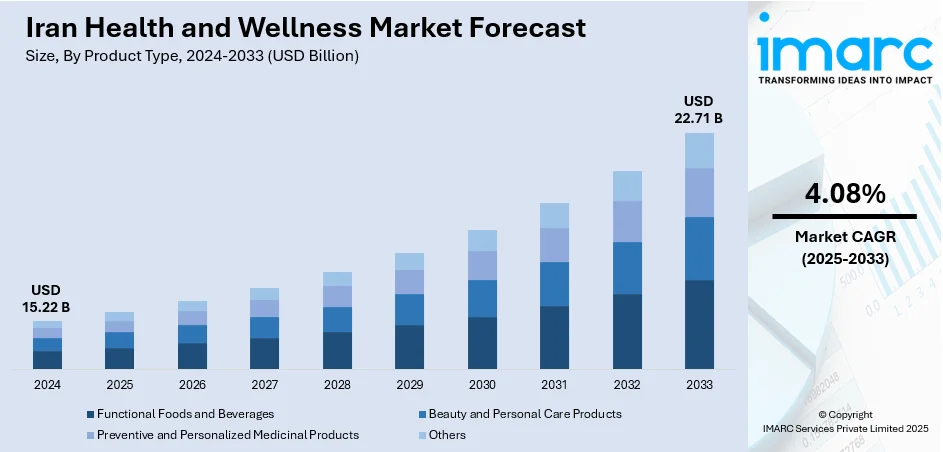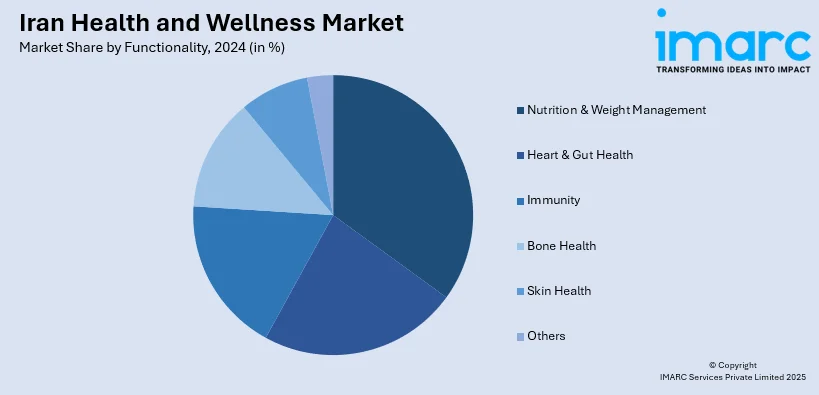
Iran Health and Wellness Market Size, Share, Trends and Forecast by Product Type, Functionality, and Region, 2025-2033
Iran Health and Wellness Market Overview:
The Iran health and wellness market size reached USD 15.22 Billion in 2024. Looking forward, the market is expected to reach USD 22.71 Billion by 2033, exhibiting a growth rate (CAGR) of 4.08% during 2025-2033. The market is fueled by a revival of classical Persian medicine, growing awareness about preventive healthcare among consumers, and demand for natural and herbal products. Urbanization and lifestyle changes have increased demand for mental well-being, physical fitness, and wholesome nutrition. Digital healthcare platforms are also becoming popular, providing teleconsultations and virtual fitness plans in local languages. This fusion of technology, cultural history, and changing lifestyles is fueling the expansion of the Iran health and wellness market share.
|
Report Attribute
|
Key Statistics
|
|---|---|
|
Base Year
|
2024
|
|
Forecast Years
|
2025-2033
|
|
Historical Years
|
2019-2024
|
| Market Size in 2024 | USD 15.22 Billion |
| Market Forecast in 2033 | USD 22.71 Billion |
| Market Growth Rate 2025-2033 | 4.08% |
Iran Health and Wellness Market Trends:
Revival of Traditional Persian Medicine and Herbal Wellness
Iran's health and wellness sector is based on its ancient heritage of Persian traditional medicine. Consumers in Tehran, Isfahan, and Shiraz increasingly use herbal remedies like chamomile, saffron, borage, and rose water, valued for their soothing, anti-inflammatory, and digestive properties. Wellness centers and pharmacies integrate new practices with old therapies—providing herbal infusions in addition to new wellness services such as yoga, mindfulness, and therapeutic massage. Mountain countryside wellness retreats in regions such as the Alborz and Zagros mountains offer immersive retreats integrating natural scenery with ancient sauna ceremonies and regional herbal baths. This blend is attractive to consumers who demand wellness with origins of cultural identity and regional biodiversity. State institutions have also started to promote Persian medical heritage via certification programs, inspiring confidence in such tried and tested practices. Increasingly, more Iranians are opting for holistic methods, and demand for integrative well-being services integrating traditional and conventional methods is transforming the domestic market.

To get more information on this market, Request Sample
Digital Health Expansion and Remote Wellness Access
Digital health and telemedicine are becoming popular in Iran, driven by widespread mobile use and increasing internet access. The most recent data issued by the CRA shows that the total count of telephone users hit 152.7 million in March 2024, representing a 3.4% increase compared to the previous year. Data indicates that by the end of March, the quantity of broadband mobile internet users in Iran exceeded 112.6 million, marking an increase of more than 7.1% from the prior year. Urban consumers in Tehran and Mashhad utilize health apps for access to remote consultations with nutritionists, mental well-being professionals, and fitness coaches in Farsi. In regular healthcare access difficulties in far-flung provinces like Sistan and Baluchestan, telemedicine fills gaps by providing diagnostic assistance, meal plans, and stress-management guidance. Local tech businesses are combining biometric monitoring with culture-crafted wellness programs—such as custom herbal supplement regimens—to suit user tastes. Online workshops on Persian cuisine and wellness practices have generated interest among new generations looking to tap into Iranian cultural heritage. This online shift promotes preventive healthcare, increases service delivery in rural areas, and builds wellness communities through social media support groups and networks of online coaches. The intersection of digital technologies with indigenous health traditions is giving rise to a new wellness ecosystem founded on access and cultural integrity, which further propels the Iran health and wellness market growth.
Wellness Tourism and Cultural Destination Experiences
Wellness tourism is also rising as an important trend in Iran's health and wellness market, as the nation capitalizes on its natural and cultural resources for destination-based health experiences. Mineral springs in areas such as Sarein, Sareyn, and Mahallat have existed for centuries for healing, and are now being redeveloped as full-service health resorts with spa treatments, natural mud therapy, and wellness packages. Architecturally, designs in such destinations tend to be Persian-inspired—featuring domed bathhouses and patios with local heating elements—to complement cultural experience. Outside therapeutic retreats, wellness tourism trade is promoting ayurvedic and Persian-Med spa therapy in high-end hotels in Isfahan and Yazd, amidst heritage districts and old gardens. Such products appeal to both regional and global visitors looking for holistic rejuvenation in combination with cultural experience. As travel resumes, wellness-oriented visitors are increasingly attracted to experiences that combine indigenous medicinal cultures with hospitality, offering new opportunities for industry growth and prompting investments in health facilities that celebrate Iran's cultural and natural strengths.
Iran Health and Wellness Market Segmentation:
IMARC Group provides an analysis of the key trends in each segment of the market, along with forecasts at the country and regional levels for 2025-2033. Our report has categorized the market based on product type and functionality.
Product Type Insights:
- Functional Foods and Beverages
- Beauty and Personal Care Products
- Preventive and Personalized Medicinal Products
- Others
The report has provided a detailed breakup and analysis of the market based on the product type. This includes functional foods and beverages, beauty and personal care products, preventive and personalized medicinal products, and others.
Functionality Insights:

- Nutrition & Weight Management
- Heart & Gut Health
- Immunity
- Bone Health
- Skin Health
- Others
A detailed breakup and analysis of the market based on the functionality has also been provided in the report. This includes nutrition & weight management, heart & gut health, immunity, bone health, skin health, and others.
Regional Insights:
- Tehran
- Khuzestan
- Bushehr
- Esfahan
- Khorasan
- Others
The report has also provided a comprehensive analysis of all the major regional markets, which include Tehran, Khuzestan, Bushehr, Esfahan, Khorasan, and others.
Competitive Landscape:
The market research report has also provided a comprehensive analysis of the competitive landscape. Competitive analysis such as market structure, key player positioning, top winning strategies, competitive dashboard, and company evaluation quadrant has been covered in the report. Also, detailed profiles of all major companies have been provided.
Iran Health and Wellness Market Report Coverage:
| Report Features | Details |
|---|---|
| Base Year of the Analysis | 2024 |
| Historical Period | 2019-2024 |
| Forecast Period | 2025-2033 |
| Units | Billion USD |
| Scope of the Report |
Exploration of Historical Trends and Market Outlook, Industry Catalysts and Challenges, Segment-Wise Historical and Future Market Assessment:
|
| Product Types Covered | Functional Foods and Beverages, Beauty and Personal Care Products, Preventive and Personalized Medicinal Products, Others |
| Functionalities Covered | Nutrition & Weight Management, Heart & Gut Health, Immunity, Bone Health, Skin Health, Others |
| Regions Covered | Tehran, Khuzestan, Bushehr, Esfahan, Khorasan, Others |
| Customization Scope | 10% Free Customization |
| Post-Sale Analyst Support | 10-12 Weeks |
| Delivery Format | PDF and Excel through Email (We can also provide the editable version of the report in PPT/Word format on special request) |
Key Questions Answered in This Report:
- How has the Iran health and wellness market performed so far and how will it perform in the coming years?
- What is the breakup of the Iran health and wellness market on the basis of product type?
- What is the breakup of the Iran health and wellness market on the basis of functionality?
- What is the breakup of the Iran health and wellness market on the basis of region?
- What are the various stages in the value chain of the Iran health and wellness market?
- What are the key driving factors and challenges in the Iran health and wellness market?
- What is the structure of the Iran health and wellness market and who are the key players?
- What is the degree of competition in the Iran health and wellness market?
Key Benefits for Stakeholders:
- IMARC’s industry report offers a comprehensive quantitative analysis of various market segments, historical and current market trends, market forecasts, and dynamics of the Iran health and wellness market from 2019-2033.
- The research report provides the latest information on the market drivers, challenges, and opportunities in the Iran health and wellness market.
- Porter's five forces analysis assist stakeholders in assessing the impact of new entrants, competitive rivalry, supplier power, buyer power, and the threat of substitution. It helps stakeholders to analyze the level of competition within the Iran health and wellness industry and its attractiveness.
- Competitive landscape allows stakeholders to understand their competitive environment and provides an insight into the current positions of key players in the market.
Need more help?
- Speak to our experienced analysts for insights on the current market scenarios.
- Include additional segments and countries to customize the report as per your requirement.
- Gain an unparalleled competitive advantage in your domain by understanding how to utilize the report and positively impacting your operations and revenue.
- For further assistance, please connect with our analysts.
 Request Customization
Request Customization
 Speak to an Analyst
Speak to an Analyst
 Request Brochure
Request Brochure
 Inquire Before Buying
Inquire Before Buying




.webp)




.webp)












